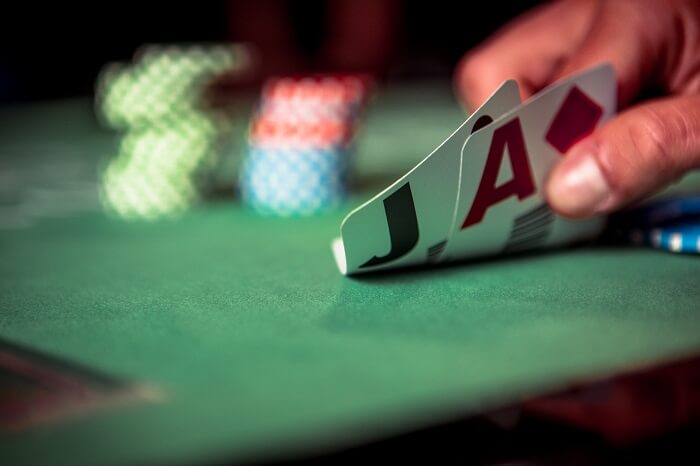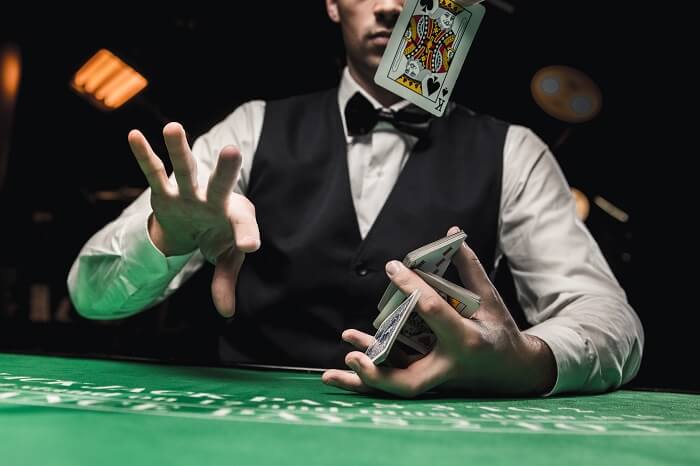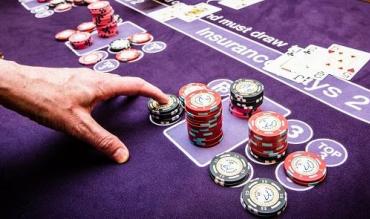So, you’ve decided to give this blackjack game a try. It looks so easy, and so profitable, in “Rainman,” “21,” and “The Hangover.”
But before you imitate Alan from “The Hangover” and plop down a $10,000 buy-in, have an idea of what you’ll do at the table. If you avoid these seven common beginner mistakes, you’ll get the most from the game.
THE MOST COMMON MISTAKES FOR BLACKJACK BEGINNERS ARE:
- Not reading the fine print
- Not knowing sign language
- Misadding the ace(s)
- Playing “what if”
- Showing off
- Believing in the team approach
- Being too serious
MISTAKE #1: NOT READING THE FINE PRINT
Deciding where to sit is important. It’s not which spot at the table you choose, but which table. Before you sit down, find out the basic rules and the minimum bet. One important factor is whether a player natural (an Ace and a 10-value card on your first two cards) gets paid at a rate of 6-to-5 or 3-to-2. That could be written in large letters on the table felt itself or be posted on a sign to the dealer’s right. If the payout is 6-to-5 – or, worse, just even money – find another table. When you get a blackjack, you should get paid 3-to-2, or $15 for a $10 bet. Tables paying 6-to-5, which are spreading like a nasty virus, pay only $12 for a natural with a $10 bet.
Another important factor is the table’s minimum bet, which usually is posted to the dealer’s right. When you’re just starting at blackjack, look for the lowest minimum you can find. Typically that’s $10 or $15, although a few spots offer $5 or even $3 minimums.
Some tables have rules that make it harder for players to win. Besides a reduced payout for naturals, they might restrict doubling to two-card totals of 9, 10 or 11 or not allow a double-down after splitting a pair. If the table has a leaflet spelling out all the rules, study it carefully before deciding to play.
BOTTOM LINE
Rule of thumb: If the game has many rule changes, it’s probably not worth your while.
MISTAKE #2: NOT KNOWING SIGN LANGUAGE
Regardless of what you see in movies and TV shows, players don’t tell the dealer “Hit me” or “I stay.” (Check out this “Simpsons” segment) In real life, players must use hand signals to indicate what they want to do. That prevents any misunderstanding and provides concrete evidence to surveillance cameras about a player’s intent. Here are the signals for a multi-deck shoe game, in which cards are dealt face up and players may not touch them: For a hit, scratch the table with your index finger; to stay, wave your hand over your cards; to double, put out your extra money (it can’t be more than your original bet, but it may be less) and flash the No. 1 sign behind your cards; to split a pair, exactly match your original bet and make a V with your first two fingers.
At a single or double-deck game that allows you to hold your cards, the signals are different. First things first: Hold the cards so they face you, but use only one hand. That rule aims to prevent cheaters from marking or switching out cards. When you want a hit, lightly brush the edge of your cards against the table felt. If you want to stay, slide the top corners of your cards under your bet. You must do this without touching the chips, a rule meant to deter cheaters who use sleight of hand to increase or lower a bet after seeing their cards. Most newcomers have trouble with this move the first few times. To tuck like a veteran, hold your cards at an angle to the table top, put slight pressure on the corner of the card just in front of your bet, and slide the cards between the bottom chip and the felt. When you double or split at a handheld, or “pitch,” game, turn your cards face up in front of your betting spot, put out the extra chips and make the appropriate hand signal.
BOTTOM LINE
No matter what type of table you’re playing, always put the extra chips on the left side of your original bet when you double or split. Never put them on top.
MISTAKE #3: MISADDING THE ACE(s)

Aces are tricky because they have two values, one and 11. So you have to consider both totals when deciding what to do. A hand of Ace-Six, for example, is worth 7 and 17 at the same time. Adding another Ace gives you 8 and 18. Adding a Three to that gives you 11 and 21.
If you’re unsure about your total, ask the dealer. A “soft” hand is when the Ace counts as 11; Ace-6 is Soft 17, for example. A “hard” hand is when the Ace counts as one – for example, Ace-6-10.
Even with Soft 17, the only way to win is if the dealer busts. Some players refuse to hit soft hands, saying “I don’t want to take the dealer’s bust card.” Don’t listen to them. Always hit Soft 17 or less.
BOTTOM LINE
Overall, never stand with Ace-Two, Ace-Three, Ace-Four, Ace-Five or Ace-Six.
MISTAKE #4: PLAYING “WHAT IF”
The most annoying way of playing blackjack is reconfiguring the hand after all the cards are dealt. Many times after the dealer makes a hand, a player reconstructs the sequence to get a different outcome. Something like: If she had hit her 12 and he had stayed on Soft 17 and she had doubled on her two-card 8, then the dealer would have busted.
Forget that. For good or ill, each person pays to play the cards however he/she likes. A few are blackjack geniuses. Most aren’t.
BOTTOM LINE
If you don’t like the way other people are playing, find a different table. Just be prepared for the next group to be even worse.
MISTAKE #5: SHOWING OFF

Some players, caught up in the casino vibe, flaunt their love of risk. They bet more than they can afford and make stupid plays simply because “I’m here to gamble.” (Watch that “Simpsons” segment again). Blackjack can be a beatable game, but remember why you’re playing. It shouldn’t be to impress friends or the strangers sitting next to you. Especially when you’re starting out, keep your bets to the minimum. Don’t feel invincible if you’re lucky enough to win two or three hands in a row. Don’t split face cards or double a seven or eight.
BOTTOM LINE
If you lose all that you intended to spend on blackjack, don’t head to the ATM. Accept that the cards simply weren’t with you tonight.
MISTAKE #6: BELIEVING IN THE TEAM APPROACH
At some point, a player is likely to say blackjack is a team sport and everyone at the table needs to work together to beat the dealer. When each player has a stiff hand and the dealer shows a bust card, the loudmouth “coach” will say, “Someone needs to take a hit.” Pay no attention. Play your cards according to basic strategy. There’s no I in blackjack, but there’s no T, E or M either.
BOTTOM LINE
Here’s a simplified basic strategy for a beginning blackjack player:
- If your first two cards total Hard 17 or more, always stand.
- If the dealer’s up-card is 7 through Ace, draw until you get at least 17.
- If the dealer’s up-card is 2 through 6, stand on Hard 12 or more.
- If your first two cards total 11, double down when the dealer’s up-card is anything other than an Ace.
- If your first two cards total 10, double down when the dealer’s up-card is 2 through 9.
- Always split Aces and 8s.
- Never take insurance, not even when you have a blackjack and the dealer’s up-card is an Ace.
MISTAKE #7: BEING TOO SERIOUS
The best reason for playing blackjack is to have fun. Unlike Alan from “The Hangover,” you’re not out to make $80,000 to rescue your brother from gangsters. If you follow the simplified strategy above, you give yourself a good chance of playing for a decent amount of time and maybe going home with a little extra money. But recognize that the house has the edge and you just as easily could lose.
BOTTOM LINE
Play smart. Play with money you can afford to lose if the cards don’t go right. And enjoy the ride. Blackjack’s a great game.
First Published on 21/3/2016


